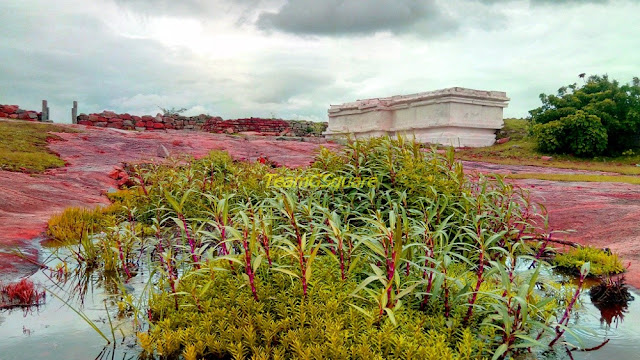 |
| A View from Top of the Ramadevara Betta, Tumkur |
We had been eyeing this big hill since a very long time as every time we stopped by the Tumkur toll booth, the hill was visible and seemed inviting. But somehow, we never got a chance to visit here. I requested one of my colleagues, a local of Tumkur to gather information about this hill as the internet searches failed to yield much results. It was only after he gave out a few details that I realized the name of this hill as 'Ramadevara Betta'. Now that I knew its name, I searched the net again and found that some people had already explored this hill and their pictures tempted me to explore it as well. One fine day, I was joined by a few of my colleagues and together we attempted to climb this hill. After packing some food from Kyatasandra, we reached the base of the hill. There is an Anjaneya temple at the hill base where we parked our vehicles and first visited this temple. We inquired about the route to Sri Ramadevara Betta and moved on.
 |
| Entering The First Tier of The Fort |
Following the directions of the temple priest, we headed towards the hill. The weather was perfect for climbing, not too hot, but cloudy and breezy. We had to cross a small hillock before we reached the base of the main hill, from where the actual trek began. The trek was wonderful, with the entire hill range of Devarayanadurga being visible. After climbing for some time, we reached the first tier of the fort or rather the first surviving tier. As we climbed further, we reached an open flat terrain where we were welcomed by a beautiful lotus pond filled to the brim due to the recent rains. Hereon, the top most tier of the fort was at a striking distance.
 |
| The Beautiful Lotus Pond |
 |
| The Temple and Pond |
 |
| Inside the Top Tier of the Fort |
We entered the last tier of the fort which had a small temple dedicated to Lord Shiva in the form of a linga. Going by its architecture, the temple seems to have been built in between the 9th and 11th centuries, probably by the Hoysalas/Cholas/Gangas. It's close resemblance to the '
Rameshwara Temple of Kaidala', situated very close to Tumkur in all likelihood indicates that these temples were built during the same time. The temple structure has a garbhagriha, an antarala and a navaranga. The Shikara is lost and many portions of the temple are ruined and lay scattered. There is a small mandapa close by to the temple where we rested and enjoyed eating our packed food, ensuring to keep the premises clean. We later went around exploring the surroundings and found a few ruins. We were able to spot two caves, one of which had a perennial spring with a few Shiva lingas while the other probably was a meditating/resting place of a sage. It started to rain heavily by the time we reached this cave and taking shelter in this cave, we wondered how someone could stay here, secluded and away from the outside world.
 |
| Ruins of Some Structure |
 |
| Arisaema sp. |
There are many interesting legends associated with this hill. As it is believed that the Linga here was originally installed by Lord Rama himself, the hill is called as 'Ramadevara Betta'. During the exile of Lord Rama, he along with his wife Goddess Sita and brother Lord Lakshmana stayed here for a brief period. Once during their stay, Lords Rama and Lakshmana were away and Goddess Sita was having a bath. When she heard them returning, she hurriedly went away from that place as she dragged her Saree while draping it. The villagers here believe that the mark present on the hill nearby the pond is that made by Goddess Sita while dragging her Saree! Quite interesting it is! However, this story may not be completely true, since Sita was kidnapped by Ravana in a location somewhere in Maharashtra, and much before they entered Karnataka. But then, the association with Lord Rama cannot be discarded as there are many places in the surroundings which prove the same.
 |
| The Mark Made by Goddess Sita's Dragging of her Saree |
Though not much history of the fort is known, it seems to have been built during the same time as the temple here, without undergoing any later modifications. The fort must have either been 2 tiered originally, which is quite unusual or it may be that the outer tiers failed to survive the test of time to give us an exact picture. Our descent was quick, though at a few places it was quite slippery due to the rains. We were pleased to have done this trek.
How to reach Tumkur Fort: Drive on NH 4 - Reach Kyatasandra - Take a right turn towards Siddaganga Mutt - Cross the Mutt, drive further and take a right at a brick kiln to reach the hill base, where there is an Anjaneya temple.













interesting!!
ReplyDeleteNice find. Beautiful pictures!!
ReplyDeleteWonderful to know about a fort in Tumakuru.
ReplyDeleteWe will be grateful to you if you give links about the history about the fort
Thank you for updating...
ReplyDeleteHistorical places...
Paramesh Aradhya kadugodi Bangalore